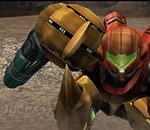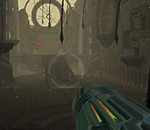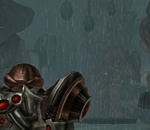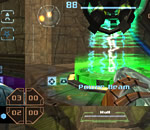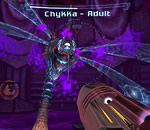Metroid Prime 2: Echoes review
The success of Metroid Prime gave Nintendo and Retro Studios a fantastic opportunity to build a sequel, extending the unique first-person gameplay and story introduced in the first title. Their efforts culminated as Metroid Prime 2: Echoes, released in late 2004.
Whenever the makers of a piece of entertainment strike gold - whether it be in the realm of novels, movies or video games (to name a few) - pressure to score another hit is often looming above their heads. Developers must always watch for danger of recycling too much old content, or cashing in on a simple clone to make quick revenue. Thankfully, Retro have largely avoided these potholes and have crafted a suitable mid-point for the Prime trilogy.
Let's start by taking a quick look at what Echoes shares with its predecessor. On a casual glance the game is quite similar in graphical standards (due to the similar game engine and GameCube console platform), and of course the entire experience is shown from Samus' first-person perspective, save for the third-person view of the Morph Ball. The design of Samus' Varia Suit has been given a facelift, with a much less bulky and more streamlined look. The control system is almost identical; it only differs with Samus' new abilities, so fans of the first game can literally jump right in from the start. The good old Scan Visor returns with a beefy Logbook for players interested in discovering more about the game's myth and lore.
The story continues the Phazon saga, this time set on planet Aether. A distress call is received from the planet, but the origin is Galactic Federation, not Space Pirate. GF command sends Samus to investigate, where she'll discover far more than GF and Space Pirate presence upon landfall.
Long ago, another Phazon-laced meteor struck Aether. While the meteor striking Tallon IV poisoned the planet's ecosystem and led to the disappearance of the native Chozo population, Aether's version brought a darker fate to the locals. Samus will eventually meet the Luminoth - giant anthropomorphised sentient moths locked in a devastating war with the Ing.
The impact of the meteor resulted in the intersection of Aether with a twisted alternate version of itself from another dimension - Dark Aether. Portals between the two worlds ripped open, and the Luminoth soon found themselves fighting for their very existence against the invading Ing. The Ing are as twisted as the world they originate from. Possessing the ability to invade and corrupt any sentient being - even the Luminoth - their threat level is on par with the X from Metroid Fusion - good thing they don't come from our universe.
After an age of fighting, the Luminoth have sealed themselves away in relative safety and are on the verge of defeat. However, Samus quickly finds herself caught up in the conflict. Fighting on behalf of the Luminoth, the salvation of their entire race rests on her shoulders. I doubt she'd expect that result from answering the odd distress call. As if the Ing and the local Space Pirate forces are enough to deal with, Samus will also encounter a new nemesis, one that tracked her all the way from Tallon IV...
Phew, what a premise. With all these factions clashing with their own agendas, you might begin to think that the classic recipe of isolation and exploration are lacking in this mission. While the dialogue interaction with friendly characters and deeper story is certainly new, the game does still present the element of isolation in a post-war environment. With the Luminoth all sealed away in hibernation, there won't be any epic war-like events; Samus is free to go about her regular business. She'll be mostly working alone in her fight against the Ing.
Samus is always finding any old excuse to lose her abilities at the start of the more recent Metroid titles, leaving players to regain them all again. Echoes is another culprit - but new suits, weapons and upgrades keep it interesting. Two new weapons - the Light Beam and Dark Beam - consume ammo with each shot to ensure that Samus' isn't too overpowered (they each work wonders against foes of the opposite-polarity's dimension, so you can see why ammo reserves are needed for the challenge factor). Luckily ammo can be found easily enough by defeating enemies with the opposite weapon, so Retro haven't made it too hard to work the system. The new Dark and Echo Visors work well, and the inclusion of the Screw Attack is a welcome treat for fans of the classic Metroid series.
A major departure from Metroid Prime many players will no doubt notice is a marked increase in difficulty level. Samus must travel between Light and Dark Aether, and the very air of Dark Aether is corrosive to her Varia Suit. This gameplay mechanic injects a nasty amount of difficulty for particular boss fights that shouldn't be taken for granted. Beginner players are going to have trouble, so Echoes is definitely not for the casual audience.
Players will also find themselves dimension-hopping between the two worlds quite often. It's a sneaky way to increase the game world size, but Light Aether still has plenty of unique environments opposite Dark Aether's purple-loving-hued wastelands. The amazing attention to detail Retro crammed into Metroid Prime's worlds is also alive and well here.
Each region is still interconnected, but this time players are essentially directed where to go next and what to do, so it won't be the same kind of experience Super Metroid and Metroid Prime offered with their lack of guidance. Backtracking is still present however, so Retro have built a good compromise between old and new. Get ready for hearty rounds of treasure-hunting too.
A more ambient musical score doesn't give as much variety and memorability as Metroid Prime's soundtrack, but fans of Super Metroid's soundtrack are going to love the selection of remixed themes. At times Dark Aether soaks up more atmosphere than Light Aether thanks to its moody melodies and its love of all things purple. With such a massive twisting world, it's very easy to find yourself absorbed - and probably a little lost at times. Thankfully the hint system from Metroid Prime returns to poke players in the right direction.
Nintendo and Retro decided to experiment with Echoes by introducing the first Metroid console multiplayer experience. The setup is simple: up to four players duke it out as Samus clones in a deathmatch-style arena in one of two game modes.
It's great to see Retro trying something new, but consider this a small added bonus to an already massive single-player component. There's enough options and variation to keep it interesting for a time, but the likes of Mario Kart and Super Smash Bros. still reign supreme for multiplayer madness on a Nintendo console.
Fans of the original Metroid Prime will no doubt find Echoes a satisfying continuation of the Phazon saga, while the wider audience will probably only appreciate the title after playing through the first game. Retro have kept the ball (or Morph Ball) rolling well, and the result is fresh, provides a good balance of new and old features and is an engrossing and worthy addition to the franchise. It's just one of the tougher days in the life of Samus Aran - but when you're fighting to end a decades-long war, catching an easy break would be too good to be true.
Written by Falcon Zero on 11 April 2010.













